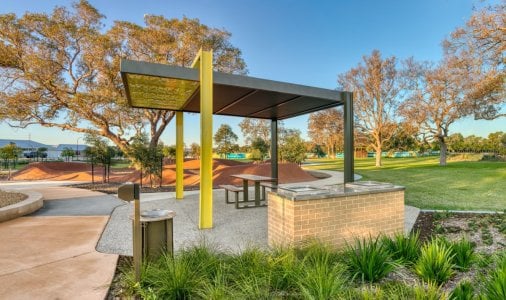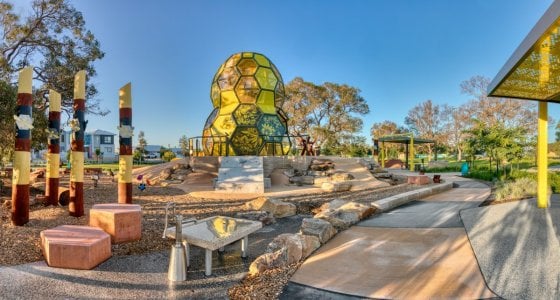Explore the future of parks in Australia: charge your phone, connect to Wi-Fi and monitor your BBQ!
Imagine walking through your local park and having your phone automatically connect to free Wi-Fi. You decide to stop for a picnic, and when you sit down on a bench, it starts charging your phone wirelessly. Hungry after all that walking? Just open an app and control the public barbecue.
This may sound like a tech-filled dream, but it's becoming a reality thanks to National Broadband Network (NBN) Co.'s new Smart Place technology, which aims to transform local parks into connected smart spaces.
In an era where smart technology is ubiquitous, NBN is thinking bigger. They recently unveiled one of their first Smart Places in Western Australia, a testament to their vision of a future where outdoor spaces are as connected as our homes.
The NBN architects have commissioned research indicating that outdoor fibre connections could more than triple by the next decade.
To take full advantage of this, NBN is encouraging government and private businesses to fund the development of Smart Places. These are 'eligible non-premises locations' that can tap into the network in the great outdoors.
They have unveiled a Smart Place called Honeycomb Park, located in Peet’s Brabham Estate, a housing development in the Perth suburb of Brabham.
This park is equipped with NBN fibre technology that not only provides park users with high-speed Wi-Fi but also powers park benches that can charge smartphones. It even connects a weather station to the irrigation system, advising when it’s the best time to water the plants.
Andrew Walsh, Head of NBN New Developments, believed this is a game-changer for governments, developers, utilities, and transport industries.
'It gives them the power of fibre just about anywhere,' he said.
The park boasts a visually stunning design with a large central playground resembling a beehive, native plants, and artworks. The park's lighting system only turns on when necessary, and the toilet block automatically locks its doors at night.
The signage in the park also mentions ‘smart waste management’, although further details were not provided.
Future plans include network-enabled community barbecues, allowing visitors to monitor it from a smartphone.
‘We’ve only scratched the surface of its potential applications—and the emergence of AI as the next big thing in tech will generate many more ways for NBN Smart Places to connect smart cities and towns across Australia,’ Walsh added.
‘A smart place (or smart cities as they’re often known) integrates technology into the surrounding built or natural environment to increase liveability, sustainability and productivity for residents and businesses,’ he explained.
However, the transition to smart cities is not without its challenges. A University of South Australia questionnaire found that 45 per cent of respondents had never heard of smart cities, and 54 per cent didn’t understand the term.
‘Judging by the survey feedback we received, the South Australian government and local councils are not achieving cut-through in explaining the concept,’ Shadi Shayan, the lead researcher, pointed out.
Furthermore, advocacy groups have criticised the concept of smart cities. One such group is Privacy International, which warned that the technology could turn our cities into 'increasingly surveilled space, where there is no longer such a thing as strolling anonymously down the streets'.
They cautioned that smart cities could risk people’s privacy and democracy, with the potential for personal data, including facial biometrics captured on CCTV, to be sold to governments and the private sector.
The Privacy International’s website stated, ‘Moreover, the smart cities we have observed have so far been reflecting already existing inequalities: built for the wealthier and for those with access to technology; they have failed to include disfranchised populations, the less-abled and to address the issue of gender inequality in cities.’
Despite these concerns, NBN is forging ahead with its Smart Place technology, with orders for non-premises connections being taken since June.

As we move towards a more connected future, it's clear that technology will play an increasingly important role in our public spaces. But as we embrace these new technologies, it's crucial that we also consider the potential implications for privacy and security.
What are your thoughts on transforming our local parks into smart spaces? Let us know in the comments below.
This may sound like a tech-filled dream, but it's becoming a reality thanks to National Broadband Network (NBN) Co.'s new Smart Place technology, which aims to transform local parks into connected smart spaces.
In an era where smart technology is ubiquitous, NBN is thinking bigger. They recently unveiled one of their first Smart Places in Western Australia, a testament to their vision of a future where outdoor spaces are as connected as our homes.
The NBN architects have commissioned research indicating that outdoor fibre connections could more than triple by the next decade.
To take full advantage of this, NBN is encouraging government and private businesses to fund the development of Smart Places. These are 'eligible non-premises locations' that can tap into the network in the great outdoors.
They have unveiled a Smart Place called Honeycomb Park, located in Peet’s Brabham Estate, a housing development in the Perth suburb of Brabham.
This park is equipped with NBN fibre technology that not only provides park users with high-speed Wi-Fi but also powers park benches that can charge smartphones. It even connects a weather station to the irrigation system, advising when it’s the best time to water the plants.
Andrew Walsh, Head of NBN New Developments, believed this is a game-changer for governments, developers, utilities, and transport industries.
'It gives them the power of fibre just about anywhere,' he said.
The park boasts a visually stunning design with a large central playground resembling a beehive, native plants, and artworks. The park's lighting system only turns on when necessary, and the toilet block automatically locks its doors at night.
The signage in the park also mentions ‘smart waste management’, although further details were not provided.
Future plans include network-enabled community barbecues, allowing visitors to monitor it from a smartphone.
‘We’ve only scratched the surface of its potential applications—and the emergence of AI as the next big thing in tech will generate many more ways for NBN Smart Places to connect smart cities and towns across Australia,’ Walsh added.
‘A smart place (or smart cities as they’re often known) integrates technology into the surrounding built or natural environment to increase liveability, sustainability and productivity for residents and businesses,’ he explained.
However, the transition to smart cities is not without its challenges. A University of South Australia questionnaire found that 45 per cent of respondents had never heard of smart cities, and 54 per cent didn’t understand the term.
‘Judging by the survey feedback we received, the South Australian government and local councils are not achieving cut-through in explaining the concept,’ Shadi Shayan, the lead researcher, pointed out.
Furthermore, advocacy groups have criticised the concept of smart cities. One such group is Privacy International, which warned that the technology could turn our cities into 'increasingly surveilled space, where there is no longer such a thing as strolling anonymously down the streets'.
They cautioned that smart cities could risk people’s privacy and democracy, with the potential for personal data, including facial biometrics captured on CCTV, to be sold to governments and the private sector.
The Privacy International’s website stated, ‘Moreover, the smart cities we have observed have so far been reflecting already existing inequalities: built for the wealthier and for those with access to technology; they have failed to include disfranchised populations, the less-abled and to address the issue of gender inequality in cities.’
Despite these concerns, NBN is forging ahead with its Smart Place technology, with orders for non-premises connections being taken since June.
Key Takeaways
- National Broadband Network Co. (NBN) has unveiled its first Smart Place in Western Australia, allowing non-premises locations to tap into the network for outdoor fibre connections.
- The Peet’s Brabham Estate's Honeycomb Park has access to NBN fibre technology, which provides high-speed Wi-Fi, powers park benches capable of charging smartphones, and activates a weather station.
- Other smart features mentioned include network-enabled community barbecues, smart lighting, automatically locking toilets, and smart waste management, though further details were not provided.
- Privacy International has voiced criticism of smart cities, highlighting they could increase surveillance and compromise personal privacy.
As we move towards a more connected future, it's clear that technology will play an increasingly important role in our public spaces. But as we embrace these new technologies, it's crucial that we also consider the potential implications for privacy and security.
What are your thoughts on transforming our local parks into smart spaces? Let us know in the comments below.









